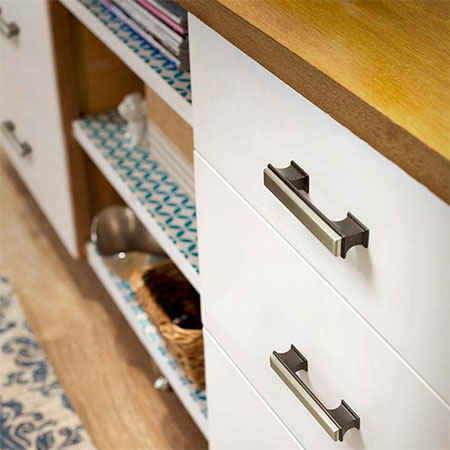Upcycling a dated secondhand dresser
Upcycling is a great way to turn secondhand bargains into feature pieces for a home.
04/03/2019
Upcycling, particularly if you have found a secondhand bargain, is a great way to add new pieces of furniture to your home. Even pieces that are in desperate need of some TLC can be given some minor adjustments and added detail to allow them to fit into your own personal style.
For this project a secondhand dresser that was in a sad state was upcycled into a useful and trendy living room dresser. You could also use it as a server in a dining room or as media unit or TV stand.
HERE'S HOW:
When you find a piece of furniture that has good bones and a solid structure, or even one that just needs a bit of work, it is very satisfying to spend a bit of time on upcycling to make it perfect for your home. What's nice about pieces you stumble upon in secondhand shops or online sales is that they are usually made of wood - and it's hard to come by quality wood furniture these days.
For the project an old dresser with good bones was transformed into a stylish dresser that would cost upwards of R5000 to buy, and at a cost of around R500, it was worth it to take it home, spend a weekend making alterations and changes, and painting to give it eye-catching appeal.
Assess what needs to be done
To give the dresser a new look, the centre drawers were removed and replaced with open shelves. For this particular project, the end result in a dresser that is not as closed off and chunky, and it also give a more modern look.
Whatever piece you find, think about what you need in your home, or in a particular room, and assess what can be done to transform the piece. You ideally don't want to completely disassemble the furniture - just make a few changes here and there.
Decide what materials you can use
These days we have lots of options to choose from for materials to work with. If you're not sure, take a walk through you local Builders store to see what's available, or pop online to search for options. I can spend hours on the Builders website looking for ideas for my own projects, and sometimes I end up with more ideas than I started with.
To give this dresser a more modern look, colourful geometric Contact self-adhesive vinyl was used to cover pieces of masonite to replace the drawers. The masonite shelves were glued into place on the drawer supports.
GOOD TO KNOW: Clamp the masonite overnight for a solid bond.
Applying a finish
To upcycle the remaining drawers and cabinet frame, these elements were sanded with 120-grit sandpaper to remove scratches and then finished off with 180-grit for a smooth finish ready for painting. If there are gouges or chips you need to fix these before painting. Use wood filler for shallow scratches and Alcolin QuikWood to replace missing chunks.
Paint is an easy way to update any piece of furniture but not everyone likes to cover up wood, so choose the type of finish you want as a personal preference. You can paint, stain, seal or varnish in matt or gloss, depending on your preference.
Finishing Details
An important detail when upcycling any piece of furniture is the finishing details. Unless fittings are antique and can be restored to their original condition, you will want to add new hardware and accessories. Not only will new handles or knobs look good, they will also bring the piece of furniture up to date, or allow it to complement the decorating style of your home.
The original dresser did not have any legs or feet and sat on the floor. To raise the unit and tie in with the new handles, brushed steel legs were fitted to the base. Because of the length of the dresser, it was necessary to add 6 legs to the base to support the weight. This is also a point you need to keep in mind when upcycling furniture.
liberty hardware












